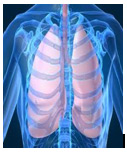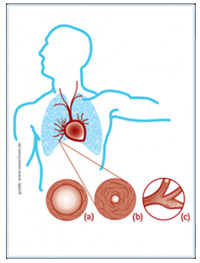What is Pulmonary Hypertension
Pulmonary hypertension is a condition characterized by a persistent increase in blood pressure in the pulmonary artery, gradually leading to the narrowing of small and medium-sized blood vessels in the lungs. The progression of this condition is slow and progressive, ultimately resulting in right ventricular heart failure. Diagnostic criteria for pulmonary hypertension include an average pulmonary artery pressure exceeding 25 mmHg at rest (normal range: 9–16 mmHg) and exceeding 30 mmHg under stress.
 The pulmonary circulation begins with the right ventricle, where venous blood enters through the pulmonary artery. Small vessels branch out in lung tissue, facilitating gas exchange and turning the blood into oxygen-enriched arterial blood.
The pulmonary circulation begins with the right ventricle, where venous blood enters through the pulmonary artery. Small vessels branch out in lung tissue, facilitating gas exchange and turning the blood into oxygen-enriched arterial blood.
Arterial blood is then collected in four pulmonary veins that drain into the left atrium. After circulating through the systemic circulation (heart, brain, kidneys, and other organs and tissues), venous blood returns through the tricuspid valve to the right ventricle. During the disease, factors lead to the narrowing of pulmonary artery branches due to thickening of their walls. This increases resistance to blood flow in pulmonary vessels, sometimes up to 5-10 times higher than normal, resulting in elevated pressure in the right ventricle and pulmonary artery, occasionally reaching 100 mmHg or more.
The right ventricle must work faster to pump blood into the pulmonary circulation. The ventricular wall hypertrophies and gradually weakens, leading to the development of right ventricular failure, characterized by blood congestion in the liver, edema, and abdominal distension. Common symptoms of pulmonary hypertension include progressive shortness of breath, sudden weakness, fatigue during exertion, dizziness, and sometimes fainting during physical exertion. Other symptoms may include a dry cough, coughing up blood, and changes in voice (hoarseness, wheezing). Later stages of the condition may involve lower limb swelling, and there is a sharp decrease in overall work capacity.
 A) – Cross-section of a normal pulmonary artery
A) – Cross-section of a normal pulmonary artery
B) – Cross-section of an arterial pulmonary artery narrowed due to the progression of the disease
C) – Longitudinal section with pathological changes in the vessels, including dilated vessels with accumulated blood clots, increasing the workload on the heart to pump blood through the lungs.

 About the association
About the association